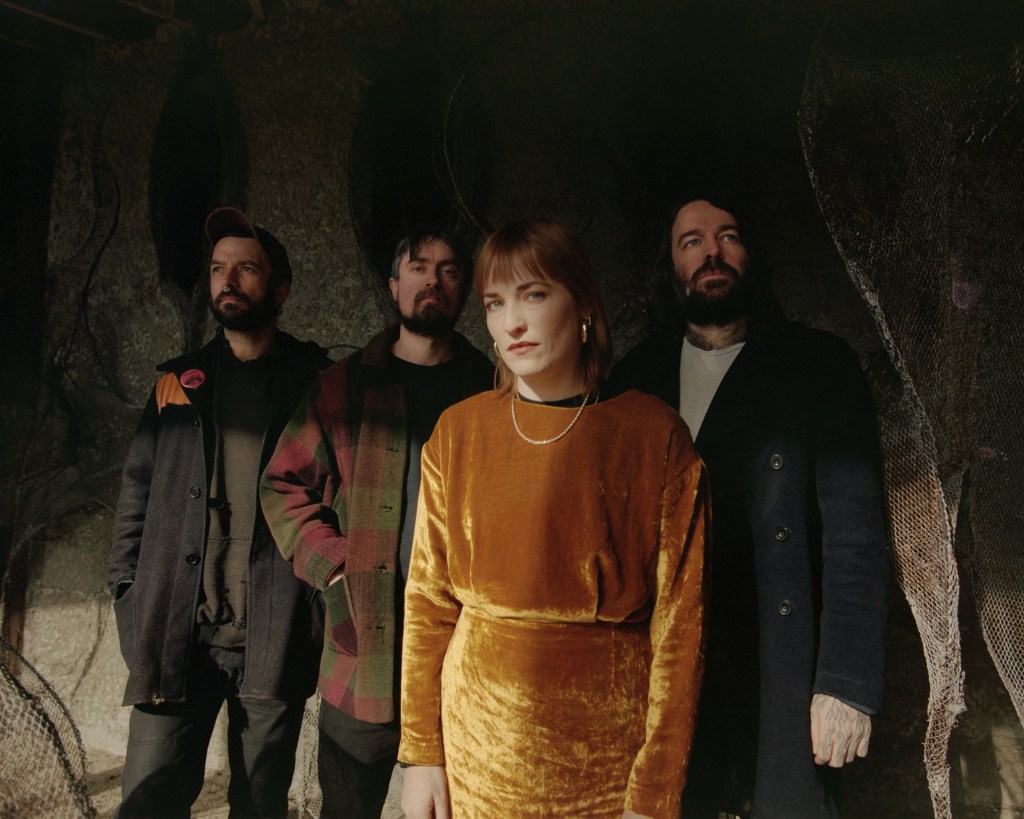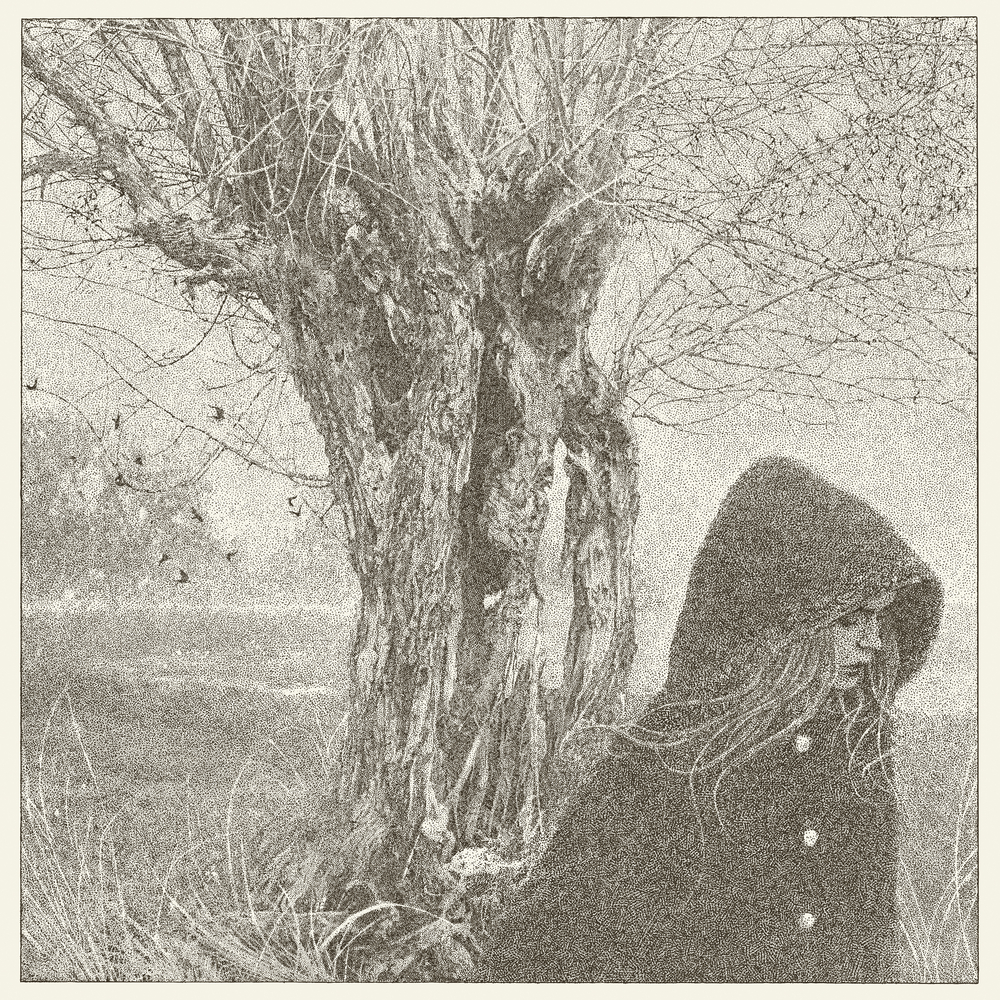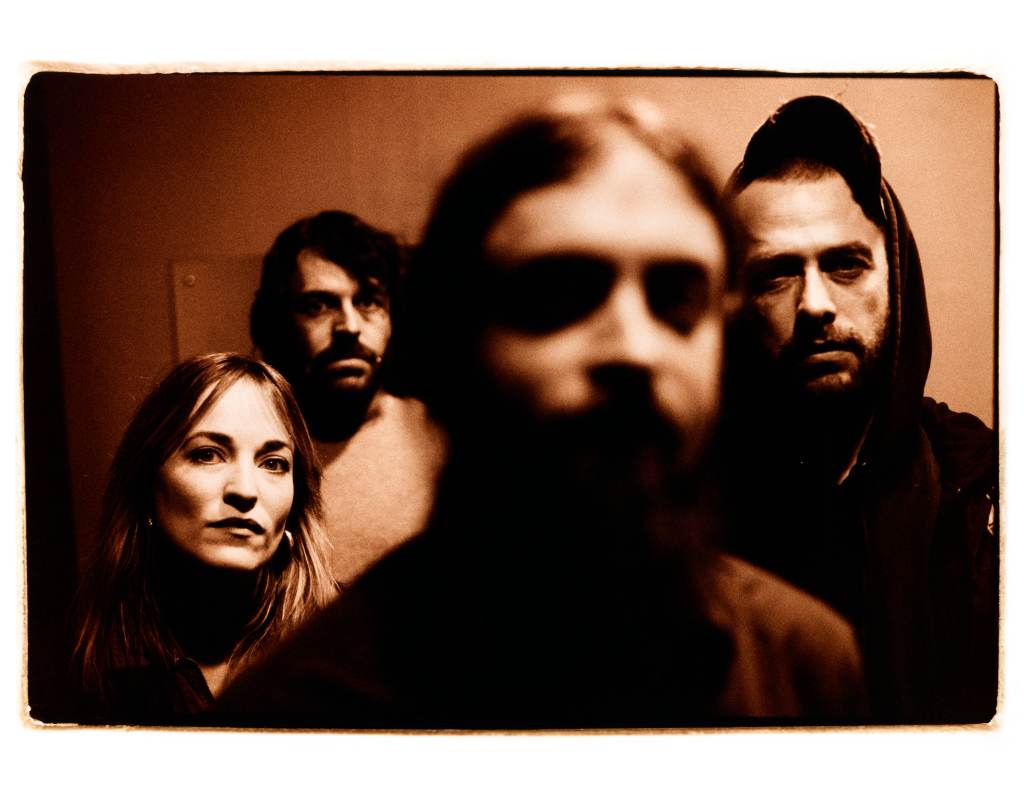
Technology, eh. It’s lovely to conduct video interviews these days, but if the connection goes a bit awry, you struggle a bit.
It’s not like it was down to mere distance, either. Ian Lynch and Radie Peat, from the Dublin band Lankum, were just across town from each other, Ian coming through loud and clear while a time delay and dodgy sound made it a struggle for Radie.
That’s me over-explaining why Ian does much of the talking here, but it’s the music that speaks volumes, and on that front Lankum are true artisans in communication, having just delivered a wonderful fourth LP, False Lankum, a third for Rough Trade Records and for my ears their best yet, carrying on where they left off with 2019’s wondrous The Livelong Day.
And that’s where I came in with Radie, while Ian was wrapping up another interview, the gap between my gushing praise and her modest response a few seconds as we tried to get into the swing of things.
“Thanks. It feels nice to get it out.”
The new record started coming together in early 2021, the band – Radie and Ian joined by Ian’s brother, Daragh Lynch, and Cormac MacDiarmada – overlooking Dublin Bay from a Martello tower close to one housing James Joyce’s museum, only realising later that almost every song had some sort of reference to the sea.
Then they began recording, overlooking the city at Hellfire Studio, sleeping each night back at that 19th century defensive fort. The result? A somewhat startling record, soon drawing you in, lead single/opener ‘Go Dig My Grave’ (from Robert Johnson’s ‘A Forlorn Lover’s Complaint’, c.1611) seeing Radie ‘showing us Hell before they show us Heaven.’
As their press people put it, this is a band – ‘folk radicals’ is the term I’m tending to see, and that sounds about right – that plays together ‘as though they are a single lung, with sounds expanding and collapsing from indistinguishable mouths, bellies, fingers, keys and feet, creating not so much a wall but an orb of sound.’

That was evident before this LP, not least on the song that first snared me, ‘The Wild Rover’, from 2019’s The Livelong Day, that album seen as one breaking Lankum out of the mould of ‘Irish traditional’ or ‘folk’ music, paving the way to critical and commercial success, earning them that year’s RTE Choice Music Prize and resulting in Vicar Street shows in Dublin selling out in 20 minutes.
And there are so many highlights this time, not least Cormac’s first time singing a full song on a Lankum LP, ‘Lord Abore and Mary Flynn’, and second single ‘Newcastle’, an achingly heartbreaking tale of pain, of longing for love and for home, again with a timeless melody.
Then there are the 12-track album’s originals, ‘Netta Perseus’ and ‘The Turn’, both penned by Daragh. And as I put it to Radie, it sounds like they truly immersed themselves in order to bring this record about.
“Yeah, that was while we were writing it, and that’s where we were living while we were recording. The whole experience of the album is very much that we were all together in that place. And immersion is the right term, because usually we would be, you know, getting on with our normal lives then kind of meeting up to write or record, but because of the circumstances with Covid, it was just like, go and be all together in one place through the whole thing, which is a lot more intense and makes it a different way of working as well.”
Is that right that it took a while to realise there was a link among the themes of the songs, with regard to the sea playing a huge part in it all?
“Yeah, we’re not very prescriptive, if that’s the word. We don’t decide before we go in what we’re aiming for in terms of over-arching themes. Usually, it’s just subconscious, and comes to light after.”
Is Hellfire Studio on the other side of town from where you were based?
“Hellfire is kind of more up the mountains, closer to the tower than where I am now, but out of the city and up in the mountains, quite rural, with an amazing view from there. And it’s a studio, but there’s cattle as well, so we’d be recording tracks then go out, and there’s lots of cows.”

By now, Ian has joined us as I confess to both of my interviewees that I was somewhat late to the Lankum party, only on board since The Livelong Day landed on my desk, courtesy of Ben Ayres at Rough Trade. It stood out amid several records put my way pre-lockdown, and I felt I had to know more. And when I conveyed that sense of wonder to Ben, he clearly wasn’t surprised that it appealed to me. I’ve certainly made up for lost time anyway, receiving an introductory ‘cool’ from Ian for my admission.
How would you say you’ve changed in getting on for a decade now as Lankum? You were never mainstream Irish folk, clearly, but you’ve clearly gone down your own road from more rootsy beginnings. And how much of that resultant journey was down to your ‘fifth member’, producer John ‘Spud’ Murphy (credited on the previous LP for his ‘metaphysical counselling’)? Was it largely down to his studio techniques, or just a natural progression?
Ian stepped up this time.
“Erm, I would say it’s a bit of both, you know. I think there were elements of our sound that, if I look back on the last four albums, I can see there’s a thread we’ve been following. I think there’s elements of that even on the first album {Cold Old Fire, 2015}. There’s more drone-heavy tracks, like ‘The Tri-Coloured House’ with that extended drone piece in the middle, and ‘Lullaby’, and I think that was the stuff we were most excited about.
“But I think in a way, we had to kind of like misrepresent ourselves, because anytime we were doing anything for the radio, they all wanted three or three and a half minute songs. If you’re going on to a TV show, it’s like, ‘Oh, will you do ‘Salonika’ and ‘Cold Old Fire?’ or whatever. So, I don’t think that side of the band was really coming out.
“I think then, going on to Between the Earth and Sky {2017}, we wanted to kind of develop that side of things more. But we didn’t really know what we were doing. It was just that we had this idea, the four of us, going, ‘We want to get these bigger sounds and more drone-heavy sounds out of the instruments that we have.’
“And it wasn’t until Spud came down that he could get some really heavy ‘low-end’ out of those instruments. Since then we’ve been kind of ramping it up the whole time, seeing how far we can take it.”
I gather the linking pieces – fugues – on this new LP started life as one track, ‘Sheep Stealer’, spliced up. And that’s something not enough musicians do, I suggested. Off the top of my head, I can only think of Paul Weller’s 22 Dreams as an example. It’s something I really like though, and works so well. It’s certainly not just a case of ‘have drone, will travel’. There’s a lot more to it than that.

“Ha! Yeah, I think it’s something we had been interested in doing, and we’ve discussed for a number of years. It was in our gigs, just having one extended piece of music, whereby one track would lead into another, and maybe some segments in the middle that would join up certain pieces of music, which we never got around to doing.
“It was only really during lockdown that we kind of put a bit more work into that. We did a live-stream thing from the Abbey Theatre in Dublin, ‘A National Disgrace’, where we were able to work those elements. We played the entire thing in two different segments, 45 minutes each. And within that we were kind of experimenting, linking up songs with separate drone pieces, using samples and stuff like that. That was really exciting, and I think that led on to us wanting to do something similar with the album.”
The day ‘Go Dig My Grave’ was released online, I saw a tongue-in-cheek online comment regarding an imaginary conversation between you and a record company executive, them telling you that you were on the cusp of crossover success, suggesting, ‘maybe lean into the accessible acoustic folk numbers and we can hit the mainstream’, your response being to release a ‘nine-minute funeral dirge from hell.’ Not far off the mark, I’d say. But I love that you don’t seem overly concerned about chart or commercial success.
“No, I don’t think that kind of thing has ever motivated us. We just want to make the music that we like making, really.”
When I shared that first single online, one friend said it was well timed, the latest record from your One Leg One Eye side-project, Ian, having arrived in the post that day, so he was looking forward to going off and listening to that. And you’re clearly not a band to stand still. Is that right that you’re not long back from a lecture tour of America?
“That was last October.”
I get the impression you don’t live in each other’s pockets.
“Yeah, we’ve all got our different projects going on, you know, and all like to stay busy, doing different things. And you have to these days. It’s not like you can just be in a band, and that can be the one thing. You need to have a load of different side-hustles on the go!”

Track two, the exquisitely gorgeous ‘Clear Away in the Morning’, for me is perhaps more akin to Richard and Linda Thompson, those folk elements in there somewhere. But again, you take it somewhere else altogether.
“Yeah, I think the way we understand it, or the way we see it, is that we wouldn’t really call the music we make folk. The term isn’t used as much in Ireland anyway, but even traditional … we all know what traditional music is, and all know that what we make is not traditional music.
“It’s obviously one strong element of what we do, but amongst many other things. But maybe it’s easier to let other people define and analyse to what degree those things are there. We just like making the music, we don’t try and pass all that down, you know.”
I read how all the band members bring in songs in to potentially cover. What was it, Radie, you heard on Jean Ritchie’s 1963 take on ‘Go Dig My Grave’ that made you think it could work for Lankum?
“I just loved that song. I didn’t think it was going to work as a Lankum song for years, but I was tinkering with it, thought it would probably go on a solo album, then it just kind of floated up into my memory or my head or whatever, when we were getting together the material for this album.
“Hearing the kind of stuff we were writing, I thought it would bring another element to it. It was very obvious it would fit, and it was really easy that day, trying to figure out what to do with it. It came together really fast. Sometimes that happens. Sometimes it’s fast, sometimes it’s really obvious which songs are the right ones, and sometimes it’s not. You just have to work them all, see what jumps out.”
There are two originals on this album, but to me it has the feel of being a whole album of originals, just because of the way you operate as a band.
Ian: “Well, yeah, maybe!”

‘The New York Trader’ is outwardly more traditional sea shanty fare. But I like the idea of, for example, an American tourist stumbling upon you playing that in a pub on a remote part of the coast or down on a slipway, in a Fisherman’s Friends style, then getting drawn in by its majestic beauty, ultimately being dashed on the rocks by its sheer power. And this is what you do, going somewhere with a song, drawing us in, then taking us on that wild ride. And it works so well.
Ian: “Ah, thank you!”
But then, on this album, you go straight into the sweet folk melody of the gorgeous ‘Lord Abore and Mary Flynn’. A genius move. I gather Cormac’s been playing that a while. Had you considered recording it before this album, or is it just something that felt right this time?
Ian: “I think he’d been planning it for a while, but I don’t know … maybe you were, Ray, when we were recording The Livelong Day?”
Radie: “I’d been at him to bring it forward for a couple of years. He’s been playing that for years and years. And he’s been playing it in that arrangement for about eight years. And I just love it. It’s brilliant, and that coming after ‘The New York Trader’, I think a lot of the balance on the album is about contrast, you know, and some things only work because of where they come in the series of the album.
“It’s kind of tension and release, and the fugues are kind of like clearing your memory or cleaning your musical palate. Yeah, I love that contrast, and how full and heavy ‘The New York Trader’ becomes, and then you’ve got this lovely … wispy thing then.”
It’s a record that stays its considerable distance too, and somehow you’re left wanting more as ‘The Turn’ – like a dramatic reworking of prime Simon & Garfunkel, although perhaps less ‘I Am a Rock’ and more ‘I Struck a Rock’ – reaches its dramatic conclusion (arguably entombed again, where we started out), not something you might expect from a 13-minute finale. Glorious.
Anyway, talking of impressive reinterpretations of the nine concentric circles of torment, I gather, Radie, you’re something of a scholar of Dante’s Inferno in Italian.
“Yeah, I studied The Divine Comedy. I started reading it when I was 19, in university. And yeah, it’s still probably the most amazing work of literature I’ve ever read. It’s wild stuff! I’m really glad that some of the imagery made its way onto the cover, and Ian also loves that artist.

“I don’t know if he came at it through The Divine Comedy angle, but he had discovered Gustave Dore, I think, through his other work. So that was like a point that we really had in common, that we loved all that. But you can’t get any more ‘high drama’ than The Divine Comedy!”
There’s kind of a parallel here for me – and you can shoot me down on this one – with the imagery arguably a 2023 take on The Pogues’ Rum, Sodomy and The Lash using The Raft of the Medusa on its cover 38 years before.
Radie: “Yeah, one of the Dore images is from The Rime of the Ancient Mariner, the guy on the prow of the ship being swept by the wave. It definitely looks like it fulfils that album cover by The Pogues. I liked that crossover. Very subtle!”
Forthcoming live highlights include a sell-out at London’s Barbican on Thursday, May 4th, with their biggest headline gig to date following across the city at The Roundhouse in December, their upcoming tour almost completely sold out already, the band also set for key European dates. How easy will it be to translate all of this on the record to the live Lankum experience for these forthcoming shows? Because for a four-piece you certainly carry a bit of a punch.
Ian: “Yeah, that’s something we’re still working on now, to be honest. We’ve got about another month until our first gig. So yeah, it’s just another part of the whole process for us, trying to figure out how we’re going to arrange the songs live, because doing what we do in the studio is one thing, but quite often we end up playing different instruments or having to figure out new bits completely.
“But that’s fun as well. It just has to be done, and that’s where we’re at now.”
And to bring it full circle, I’ll say the same to Ian – congratulations on another wonderful record. It’s really something special.
Ian: “Ah, thanks very much.”

For more information about Lankum, new album, False Lankum, its predecessors, and the band’s forthcoming live dates, head to their www.lankumdublin.com website. You can also follow them via www.facebook.com/dublinfolkmiscreants, www.instagram.com/lankumdublin/ and www.twitter.com/lankumdublin/.
